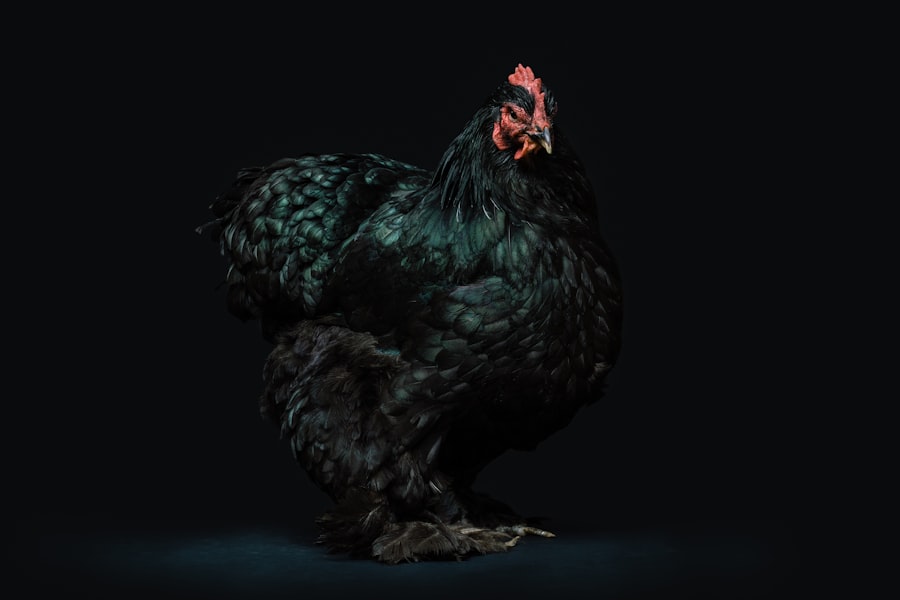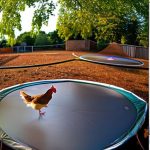Keeping chickens can be a fun and rewarding experience, but it’s important to understand the costs involved before getting started. While chickens can provide fresh eggs, natural pest control, and companionship, there are several expenses to consider. From building a chicken coop to providing feed and healthcare, the cost of keeping chickens can add up. By understanding these costs, you can make an informed decision about whether keeping chickens is right for you.
Key Takeaways
- Building a chicken coop can be a significant initial investment.
- Chicken feed is the biggest ongoing expense when keeping chickens.
- A watering system is necessary to keep chickens hydrated and healthy.
- Lighting is important for keeping chickens warm and happy.
- Bedding is essential for creating a comfortable environment for chickens.
Initial Investment: Cost of Building a Chicken Coop
One of the biggest expenses when it comes to keeping chickens is building a chicken coop. A chicken coop provides a safe and comfortable environment for your chickens to live in. The cost of building a chicken coop can vary depending on several factors, including size, materials, and design.
The size of your chicken coop will depend on the number of chickens you plan to keep. It’s important to provide enough space for each chicken to move around comfortably and have access to nesting boxes and perches. The larger the coop, the more materials you will need, which can increase the cost.
The materials you choose for your chicken coop can also affect the cost. While you can opt for more affordable options like plywood or recycled materials, higher-quality materials like cedar or pressure-treated wood may be more expensive but offer better durability and protection against the elements.
Lastly, the design of your chicken coop can impact the cost as well. If you choose a more elaborate design with additional features like windows or ventilation systems, it may increase the overall cost of construction. However, it’s important to prioritize functionality and safety over aesthetics when building a chicken coop.
Chicken Feed: The Biggest Expense
One of the biggest ongoing expenses when keeping chickens is chicken feed. Chickens require a balanced diet to stay healthy and produce eggs regularly. The cost of chicken feed can vary depending on the type of feed and the number of chickens you have.
There are several types of chicken feed available, including pellets, crumbles, and mash. Pellets are the most common type and are usually more expensive than crumbles or mash. However, pellets offer a more balanced diet and are less likely to be wasted by chickens.
The number of chickens you have will also impact the cost of chicken feed. Chickens typically consume around 1/4 to 1/2 pound of feed per day, depending on their size and breed. Therefore, the more chickens you have, the more feed you will need to provide.
To reduce the cost of chicken feed, some chicken owners choose to supplement their chickens’ diet with kitchen scraps or allow them to free-range and forage for insects and plants. However, it’s important to ensure that your chickens are still receiving a balanced diet and not relying solely on these supplemental sources.
Watering System: Cost of Keeping Chickens Hydrated
Chickens need access to clean water at all times to stay hydrated and healthy. The cost of a watering system will depend on the type of system you choose and the number of chickens you have.
There are several options for watering systems, including traditional waterers, nipple waterers, and automatic waterers. Traditional waterers are the most affordable option but require regular cleaning and refilling. Nipple waterers are more expensive upfront but provide a constant supply of clean water and reduce the risk of contamination. Automatic waterers are the most convenient option but can be quite expensive.
The number of chickens you have will also impact the cost of a watering system. You will need to ensure that there is enough access to water for all your chickens, especially during hot weather when they may drink more frequently.
Lighting: Keeping Chickens Warm and Happy
Chickens require a certain amount of light to stay healthy and happy. The cost of lighting will depend on the type of lighting you choose and the size of your coop.
Natural light is ideal for chickens, but during the winter months or in areas with limited sunlight, supplemental lighting may be necessary. This can be achieved through the use of artificial lighting, such as LED bulbs or fluorescent lights.
The cost of lighting will depend on the type of lighting you choose and the size of your coop. LED bulbs are more energy-efficient and have a longer lifespan but can be more expensive upfront. Fluorescent lights are more affordable but may require more frequent replacement.
It’s important to provide enough light for your chickens to maintain their natural circadian rhythm and encourage egg production. On average, chickens require around 14-16 hours of light per day to stay healthy and productive.
Bedding: Creating a Comfortable Environment for Chickens

Bedding is important for keeping chickens comfortable and healthy. It provides insulation, absorbs moisture, and helps control odors in the coop. The cost of bedding will depend on the type of bedding you choose and the size of your coop.
There are several options for chicken coop bedding, including straw, wood shavings, hay, and sand. Straw is one of the most affordable options but may not provide as much insulation or absorbency as other materials. Wood shavings are a popular choice as they are relatively inexpensive and provide good insulation and absorbency. Hay is another option but can be more expensive and may not provide as much absorbency. Sand is a more expensive option upfront but offers excellent drainage and is easy to clean.
The size of your coop will determine how much bedding you need. It’s important to provide enough bedding to cover the floor of the coop with a layer that is at least a few inches thick. This will help keep your chickens comfortable and prevent them from developing foot problems or respiratory issues.
Health Care: Cost of Keeping Chickens Healthy
Keeping chickens healthy is important for their well-being and egg production. The cost of health care will depend on the type of care your chickens need and the number of chickens you have.
Regular health care for chickens includes vaccinations, deworming, and general check-ups. The cost of vaccinations and deworming medications will vary depending on your location and the specific needs of your chickens. It’s important to consult with a veterinarian who specializes in poultry to determine the appropriate vaccinations and medications for your flock.
In addition to regular health care, there may be additional costs associated with treating illnesses or injuries. Chickens can be susceptible to various diseases and injuries, so it’s important to have a plan in place for emergencies. This may include setting aside a budget for unexpected veterinary expenses or investing in a first aid kit for your chickens.
Predator Protection: Keeping Chickens Safe from Predators
Predators can be a threat to your chickens, so it’s important to take steps to protect them. The cost of predator protection will depend on the type of protection you choose and the size of your coop.
Common predators that may pose a threat to chickens include raccoons, foxes, coyotes, snakes, and birds of prey. To protect your chickens, you can invest in secure fencing, predator-proof locks on doors and windows, and even electric fencing if necessary.
The cost of predator protection will depend on the size of your coop and the level of security you require. It’s important to invest in high-quality materials that are durable and can withstand attempts by predators to gain access to your chickens.
Miscellaneous Expenses: Other Costs to Consider
In addition to the main expenses mentioned above, there are other costs to consider when keeping chickens. These may include permits or licenses required by your local government, as well as equipment such as feeders, nest boxes, heat lamps, and cleaning supplies.
The cost of permits or licenses will vary depending on your location and the regulations in place. It’s important to research and comply with any requirements to avoid fines or penalties.
The cost of equipment will depend on the size of your coop and the specific needs of your chickens. It’s important to invest in high-quality equipment that is durable and designed for use with chickens. This will help ensure the safety and well-being of your flock.
Determining the Average Cost of Keeping Chickens with a Coop
The cost of keeping chickens with a coop will vary depending on a number of factors, including the size of your coop, the number of chickens you have, and the specific needs of your flock. By considering all of the expenses involved, you can determine the average cost of keeping chickens and decide if it’s right for you.
It’s important to budget for both the initial investment and ongoing expenses when keeping chickens. While there are costs involved, many chicken owners find that the benefits outweigh the expenses. Fresh eggs, natural pest control, and the joy of caring for animals can make keeping chickens a rewarding experience.
If you’re interested in learning more about the average cost to keep chickens, you might also find our article on “How to Insulate a Chicken Coop” helpful. Insulating your chicken coop can be an important step in ensuring the comfort and well-being of your flock, especially during colder months. It can also help to reduce heating costs and prevent drafts. Check out our guide on how to insulate a chicken coop for practical tips and advice.
FAQs
What is the average cost to keep chickens?
The average cost to keep chickens varies depending on factors such as the number of chickens, the type of feed, and the cost of housing. However, on average, it can cost between $300 to $500 per year to keep a small flock of chickens.
What are the initial costs of keeping chickens?
The initial costs of keeping chickens include purchasing a coop, feeders, waterers, and bedding. The cost of these items can range from $200 to $500 depending on the size and quality of the equipment.
What is the cost of chicken feed?
The cost of chicken feed varies depending on the type of feed and the number of chickens. On average, it can cost between $15 to $30 per month to feed a small flock of chickens.
What are the costs of chicken healthcare?
The costs of chicken healthcare can vary depending on the health of the chickens and the type of care needed. Basic healthcare costs can include vaccinations, deworming, and parasite control, which can cost between $50 to $100 per year.
What are the costs of chicken housing?
The costs of chicken housing can vary depending on the size and quality of the coop. On average, it can cost between $200 to $500 to purchase a coop for a small flock of chickens.
What are the costs of chicken bedding?
The costs of chicken bedding can vary depending on the type of bedding used and the number of chickens. On average, it can cost between $20 to $50 per month to provide bedding for a small flock of chickens.
Meet Walter, the feathered-friend fanatic of Florida! Nestled in the sunshine state, Walter struts through life with his feathered companions, clucking his way to happiness. With a coop that’s fancier than a five-star hotel, he’s the Don Juan of the chicken world. When he’s not teaching his hens to do the cha-cha, you’ll find him in a heated debate with his prized rooster, Sir Clucks-a-Lot. Walter’s poultry passion is no yolk; he’s the sunny-side-up guy you never knew you needed in your flock of friends!







